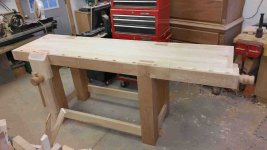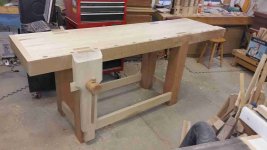ttalma
Well-known member
I am sick of my pine, plywood, and MDF, twisted, wobbly bench, and am ready to build a new one. I am looking for opinions on the length. currently I am planning on a 6' bench. But I could get away with an 8' one. But really I can only think of 2 times I would have needed a bench that long, and as we all know a shop is never big enough! I'm also planning on making it 24" deep.
I would like to hear others opinions, should I make it 8'? Is there a better size than 24" for the depth?
Secondly I have a piece of cherry that is 6"x12" that I plan to use for the legs. I plan to cut it down the center so I have 6"x6" pieces. The tree was cut down after it had been dead a long time, the board was milled and has been air drying 8 years. There is very minor checking, I am pretty sure with a board this size the center is still wet. I won't start the bench for at least a month, probably 2. I want to minimize warping, Should I cut it now and let it start drying, or should I cut it right before I'm ready to use it?
I would like to hear others opinions, should I make it 8'? Is there a better size than 24" for the depth?
Secondly I have a piece of cherry that is 6"x12" that I plan to use for the legs. I plan to cut it down the center so I have 6"x6" pieces. The tree was cut down after it had been dead a long time, the board was milled and has been air drying 8 years. There is very minor checking, I am pretty sure with a board this size the center is still wet. I won't start the bench for at least a month, probably 2. I want to minimize warping, Should I cut it now and let it start drying, or should I cut it right before I'm ready to use it?


